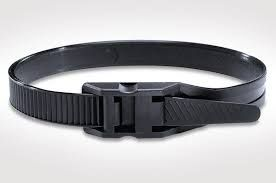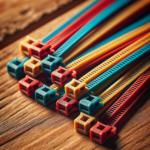Are you curious about the shelf life of cable ties and how it can impact your projects? In this guide, we'll explore the question "What is Cable Tie Shelf Life?" to provide you with all the information you need to know.
Exploring Cable Tie Shelf Life
Cable tie shelf life refers to the period during which cable ties can be stored and used effectively without compromising their quality or performance. While cable ties are known for their durability, it's essential to understand that they do have a finite shelf life, which can vary depending on various factors such as the material of the tie, storage conditions, and environmental factors.
When stored properly in a cool, dry environment away from direct sunlight and extreme temperatures, most cable ties have a shelf life of several years. However, it's crucial to inspect the ties regularly for signs of degradation, such as brittleness, discoloration, or cracking, especially if they have been stored for an extended period. If any of these signs are present, it's best to discard the ties and use new ones to ensure a secure and reliable hold.
Factors Affecting Shelf Life
Several factors can affect the shelf life of cable ties, including:
1. Material Composition
The material composition of the cable tie plays a significant role in determining its shelf life. Nylon cable ties, for example, are known for their durability and resistance to environmental factors, making them suitable for long-term storage. However, other materials may degrade more quickly over time, especially if exposed to harsh conditions.
2. Storage Conditions
Proper storage conditions are essential for maintaining the integrity of cable ties and extending their shelf life. Store cable ties in a cool, dry place away from direct sunlight, moisture, and extreme temperatures. Avoid storing them in areas prone to temperature fluctuations or high humidity, as these conditions can accelerate degradation.
3. Environmental Factors
Environmental factors such as exposure to UV radiation, chemicals, or moisture can also impact the shelf life of cable ties. UV radiation, in particular, can cause nylon cable ties to degrade over time, leading to reduced strength and durability. Similarly, exposure to chemicals or moisture can cause corrosion or weakening of the tie material.
How Different Materials Affect Cable Tie Longevity

The material composition of cable ties plays a significant role in determining their longevity and durability. Here's how different materials can affect the lifespan of cable ties:
1. Nylon Cable Ties
Nylon cable ties are one of the most common types of cable ties and are known for their durability and versatility. They are resistant to moisture, corrosion, and most chemicals, making them suitable for a wide range of applications. Nylon cable ties have a relatively long lifespan when stored properly, making them ideal for both indoor and outdoor use.
2. Stainless Steel Cable Ties
Stainless steel cable ties are incredibly durable and resistant to corrosion, making them ideal for use in harsh environments. They have a long lifespan and can withstand exposure to extreme temperatures, UV radiation, and chemicals without degrading. Stainless steel cable ties are often used in industries such as aerospace, marine, and oil and gas, where reliability and durability are paramount.
3. Heat-Resistant Cable Ties
Heat-resistant cable ties are specifically designed to withstand high temperatures without melting or degrading. They are often made from materials such as polypropylene or fluoropolymer and are ideal for use in automotive, aerospace, and industrial applications where exposure to heat is a concern. Heat-resistant cable ties have a shorter lifespan compared to other materials but can still provide reliable performance in high-temperature environments.
4. Plastic Cable Ties
Plastic cable ties, such as those made from polyethylene or polypropylene, are cost-effective and versatile but may have a shorter lifespan compared to other materials. They are susceptible to degradation from UV radiation, chemicals, and moisture, especially if stored improperly or used in outdoor environments. However, with proper care and maintenance, plastic cable ties can still provide reliable performance for a variety of applications.
Best Tips to Extend Cable Tie Shelf Life
Looking to maximize the shelf life of your cable ties and ensure they remain reliable for your projects? Here are some expert tips to help you extend their lifespan:
1. Proper Storage
Proper storage is crucial for maintaining the integrity of cable ties and extending their shelf life. Store cable ties in a cool, dry place away from direct sunlight and extreme temperatures. Avoid storing them in areas prone to temperature fluctuations or high humidity, as these conditions can accelerate degradation.
2. Avoid Exposure to UV Radiation
UV radiation can cause nylon cable ties to degrade over time, leading to reduced strength and durability. To protect your cable ties from UV damage, store them in opaque containers or cabinets when not in use. If using them outdoors, choose UV-resistant cable ties specifically designed for outdoor applications.
3. Use Quality Material
Invest in high-quality cable ties made from durable materials like nylon or stainless steel. While they may be slightly more expensive upfront, quality cable ties are more resistant to environmental factors and tend to have a longer shelf life. Avoid cheap, low-quality ties that may degrade quickly and compromise your projects.
4. Regular Inspection
Periodically inspect your cable ties for signs of degradation, such as brittleness, discoloration, or cracking. If any of these signs are present, it's best to discard the ties and use new ones to ensure a secure and reliable hold. Regular inspection allows you to identify and replace damaged ties before they cause problems in your projects.
5. Avoid Exposure to Chemicals and Moisture
Exposure to chemicals or moisture can cause corrosion or weakening of the tie material, leading to reduced strength and durability. Keep cable ties away from areas where they may come into contact with chemicals or moisture, and avoid using them in environments with high humidity or condensation.
6. Handle with Care
Handle cable ties with care to avoid unnecessary stress or damage. Avoid bending or twisting the ties excessively during installation, and use proper tools when tightening or releasing them. By handling cable ties gently, you can help prevent premature wear and extend their shelf life.
Wrapping Up
By following these tips, you can maximize the shelf life of your cable ties and ensure they remain reliable for your projects. From proper storage and UV protection to using quality materials and regular inspection, taking care of your cable ties will pay off in the long run. Ready to optimize your cable management setup? Explore our selection of high-quality cable ties and accessories today!

